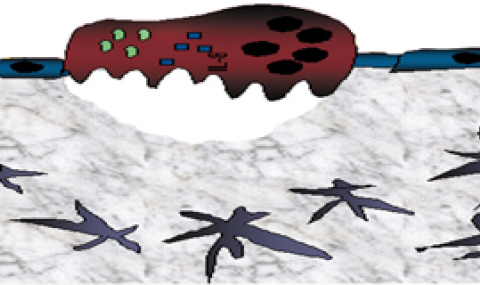Introduction: Bone marrow (BM) supporting stromal cells secrete an array of important signaling factors, in a synchronized fashion, creating a unique microenvironment required for regulation of hematopoietic stem and progenitor cells (HSPC) maintenance, localization, self-renewal and development.
The chemokine SDF-1 (also termed CXCL12), whose fine tuned levels are critical for HSPC quiescence, is the only known powerful chemotactic factor for both human and murine HSPC.
BM stromal cells rapidly respond to alarm situations by secreting SDF-1 to the circulation, promoting progenitor cell mobilization (Dar et al., ASH 2006) as part of host defense and repair mechanism.
This well synchronized event suggests that the supporting stromal cells function as a physiological syncytium. However, the mechanism governing the synchronized SDF-1 de-novo synthesis and secretion from BM stromal cells is not known.
The gap-junction (GJ) intercellular channels protein Connexins (Cx), allow the passage of secondary messengers between cells in a tissue, thus synchronizing its activity. The existence of the multi-function Cx43 and Cx45 GJ proteins in the BM compartments suggests a direct intercellular communication, coordinating their supporting capacity.
Results: In order to evaluate Cx networks involvement in the regulation of SDF-1 secretion, we first checked for Cx43 expression in the BM of mice treated with G-CSF.
We have previously shown that as part of G-CSF induced mobilization, SDF-1 levels are downregulated in the BM, thus promoting HSPC proliferation and mobilization (Petit et al., Nat.Immunol, 2002).
Cx43 was strongly downregulated both at mRNA and protein levels in the BM of G-CSF treated mice, in correlation with reduced levels of SDF-1. Hence, we asked whether Cx directly regulates SDF-1 secretion.
Treating BM stromal cells with carbenoxolone (CBX), a known Cx blocker, resulted in immediate, complete and specific blockage of SDF-1 secretion to the conditioned medium (CM).
Secretion of the cytokine HGF, measured as control, was not affected. In addition, prolonged stimulation of BM stromal cells with CBX resulted in elimination of Cx43 and Cx45 transcription, as well as SDF-1 transcription. We then evaluated the direct cell-contact necessity for SDF-1 secretion.
Equal numbers of BM stromal cells were seeded in different-sized culture plates allowing and restricting cell contact, in the same volume of medium.
SDF-1 levels in the CM were found to be significantly higher in the contacting BM stromal cell cultures compared to the non-contacting BM stromal cell cultures, while HGF levels were not affected.
Surprisingly, similar SDF-1 mRNA levels were detected in both groups. These results suggest that SDF-1 secretion, but not transcription, is a cell contact dependent event.
Next, the functional consequences of stromal Cx blockage was assessed by testing migration of human G2 cells towards CM collected from non-treated and CBX-treated BM stromal cells. G2 cells failed to migrate towards CBX-treated BM stromal cells CM.
This was further supported by in-vivo homing experiments - BM mononuclear cells were intravenously injected to PBS and CBX treated C57BL/6 recipients. CBX-treated mice exhibited reduction in homing capacities to the femoral BM, in correlation with lower BM levels of SDF-1. cAMP is a small secondary messenger transmitted by Cx between cells and thus may serve as the mediator of Cx regulated SDF-1 secretion. cAMP inhibition in BM stromal cells by MDL resulted in CBX-like effect - decreased SDF-1, Cx43 and Cx45 mRNA as well as decreased SDF-1 secretion.
Interestingly, cAMP elevation in BM stromal cells, by dbcAMP or forskolin, resulted in reversed regulation of SDF-1 and Cx43/Cx45. cAMP effect on SDF-1 is PKA-independent since pretreatment of BM stromal cells with H89 did not impair the cAMP elevation effects. Conclusions: Here we show, for the first time, that functional SDF-1 secretion from BM stromal cells is a cell contact-dependent event mediated by Cx43 and Cx45 gap junctions. We have identified dual regulatory roles of BM-Cx on SDF-1: a gap junction-free regulation of its transcription and a gap junction-dependent regulation of its secretion. We hypothesize that Cx43/Cx45 channels transmit cAMP, which in turn controls synchronized SDF-1 secretion and subsequent stem cell migration and development events.
[figure:center:1]

Connexin gap-junctions connect between BM stromal cells. A ligand can bind its receptor on a specific BM stromal cell and cause cellular activation by signal transduction. However, the signal can propagate and cause a synchronized activation of many adjacent BM stromal cells through the connexin gap-junctions.



